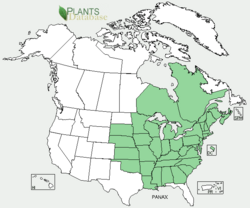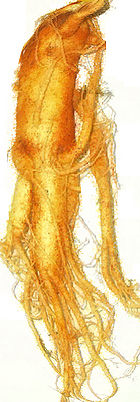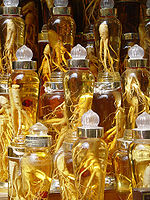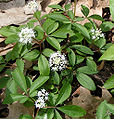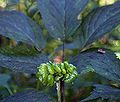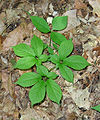Ginseng
| Ginseng |
|---|
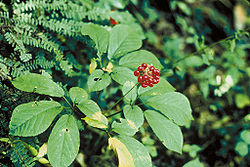
|
| Scientific Classification |
|
| Species |
|
| Growth Locations in U.S. and Canada |
Ginseng has been used over 5000 years by the Chinese. Because of the common structure of the root resembling to a human form, the name ginseng came from two words meaning "Man Plant." Ancient healers discovered that this herb help the body and mind to stay in balance. Both Chinese and Native American herbalists highly respect this amazing herb.[2]
Anatomy
Although many people confuse the plant, ginseng with other short, perennial plants such as the Virginia creeper or a young hickory, many unique differences set this plant apart from the rest. There are two main types of ginseng, American ginseng that is yellow or white in color and then there is Asiatic ginseng, which is red in color.[3][4]
In the first year, planted ginseng can produce a 3 leaflet leaf. This vegetation in the wild can grow between 7 to 21 inches height.[5]
The plants anatomy may look simplified above ground, but beneath is an extensive root system that sometimes taking the shape of a human body. In a four year period, the creamy yellow or white colored root can grow up to 3 inches long. This fleshy and fibrous taproot is the reason for it’s harvesting, and is the part that is consumed. During each spring or late summer, ginseng blooms small, gray flowers that turn into a bundle of crimson fruit, which contains the seeds.[6]
Reproduction
A ginseng seed can remain in the soil for 18 months prior to germination before seeing any sign of growth. For several years, many recently developed ginseng plants remain in their current state of just one leaf until they collect enough energy to grow two leaves.
The first year, ginseng plants are more sensitive to the elements. Even when ginseng develops flowers and seeds, the reproduction still might be low at this stage. Between year 3 and 4, the plant produces a seed stalk, which has a large cluster of 10 to 50, berries called an umbel. Each bright red berry contains between 1 and 3 seeds.[7]
Although this plant is self- pollinating, the wind and insects such as syrphid flies and halictid beetles both visit multiple species of plants while gathering nectar and pollen. Insects help the transfer of pollen from flower to flower. The primary distribution of ginseng seeds comes from gravity.[8]
Ecology
Ginseng is mostly grown in eastern Canada and the U.S.A. under the canopy of dense forests. Ginseng is mostly found in shady woodlands that supply rich soil. These plants approximately need about 70-80% shade to complete their ideal habitat. In addition, ginseng has to have a good amount of water but still have to drain, not leave the plant submerged.[9]
It is important for a natural cold/warm cycle for the seeds to germinate. Where most ginseng plants are grown, they often get browsed by deer, or experiencing a critical drought. As a result most of the plants will come back next year decreased in size, and reproductive output.[10]
Medical Uses
Outline: 1. increase physical and mental endurance, boost energy, normalize body functions, reduce cholesterol, and prevent cancer. 2. enhance sexual desire, by promoting sex hormone production. 3. supports the natural balance of your body to combat fatigue and strengthens and protects your nervous system. 4. modern research has demonstrated that over 28 therapeutic elements (ginsenosides) are in this vitamin rich plant 5. in the treatment of memory loss (Alzheimer's), balance of blood sugar levels (Diabetes), slowing down the aging process, helping the immune system, etc. 6. Women find it helpful in normalizing menstruation and easing childbirth [11]
There are countless positive affects that ginseng do towards your health. Modern researchers....
Media
Gallery
References
- ANATOMY AND CLASSIFICATION OF AMERICAN GINSENG C.P. Lyons. Trees and Shrubs and Flowers to Know in British Columbia. 2003
- About Ginseng Florence C. Lee. Asiachi.com. 1998-2005
- American Ginseng Biology NSF, LTREB. 2008
- American Ginseng's Favorite Habitat Steve Nix. The New York Times Company. 2010.
